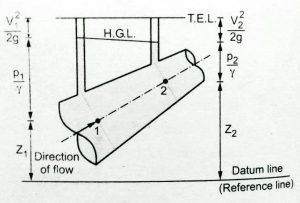In this article, we will learn about the Hydraulic Grade Line (HGL) and Total Energy Line (TEL) with a diagram and formula.

Table of Contents
Hydraulic Grade Line (HGL)
Remember HGL is also term as Hydraulic Gradient Line. It is one of the most important topics in fluid mechanics.
Consider a pipeline that is carrying a liquid from one point to the other and the piezometer is attached to this pipe at any random point.
The liquid rises in the tube and represents the pressure head (P/γ) above the center of the pipe. The height of the center of the pipe above any selected datum indicates the datum head (Z). as shown in the above figure.
It means, the liquid level in the piezometer records, the sum of (P/γ +Z) with respect to the selected datum. This is called as Piezoelectric Head.
If we place many piezometers along the pipeline at random locations, then the line joining the liquid levels in the piezometers indicates the variation of the piezoelectric head along the whole pipeline. This line is called a Hydraulic Grade Line.
What is Hydraulic Gradient Line?
The Hydraulic Gradient Line or the Hydraulic Grade Line is defined as a line joining all the liquid levels indicated by piezometers connected to the pipeline throughout. If HGL is above the center of the pipeline, the pressure is positive and HGL is below the center of the pipeline, the pressure is negative.
Above are the various reasons that the hydraulic grade line is useful.
Read More: Euler’s and Bernoulli’ equation : Derivation, Assumptions, Limitations
Total Energy Line (TEL)
When the velocity head (V²/2g) at a section is added to the piezoelectric head i.e. (P/γ +Z), then the total head (total energy) of fluid at that section is obtained as shown in the figure. Therefore, the total heads at different sections along the pipeline can be plotted.
The line joining all these points is called as Total Energy Line (TEL).
Definition: Total Energy Line or Energy Grade Line i.e. TEL is defined as a line joining the points representing the total head. It means the total energy line represents the sum of (P/γ + V²/2g + Z).
For ideal or non-viscous fluid there are no losses hence TEL for that fluid is a horizontal line.
But for real fluid, it will always slope down in the direction of flow because the energy must decrease in the direction of flow.
Conclusion:
We have discussed the hydraulic grade line (what it represents and why it is useful) and the total energy line. If you have any questions about HGL and TEL then feel free to ask in the comment box.
Thank you for sharing such great information on the hydraulic grade line.
Here is a similar article that will help your audience: https://www.enggarena.net/2019/12/types-of-hydraulic-fluids-and-their-properties.html
Hydraulic grade line is above or below the center line of the pipe.?
If pressure is negative HGL will be below the center of pipeline and if pressure is positive it will above center of pipeline.
what are we use HGL in
Why does hydraulic grade line decrease the further you go away from the source representing loss of PSI but in some water systems the highest pressures are further away from the sources?
Hi Bob. A static elevation change could cause this. So although the HGL would generally continue to decrease in magnitude, if you had a large drop down a slope, the static elevation difference between the top of the hill and the bottom of the hill could cause what you are calling the largest pressure in the system.
what is the purpose or use of hydraulic gradient line?
Useful information thank you soo much